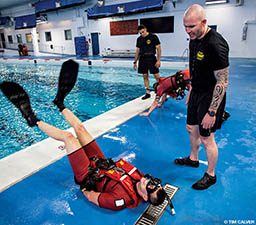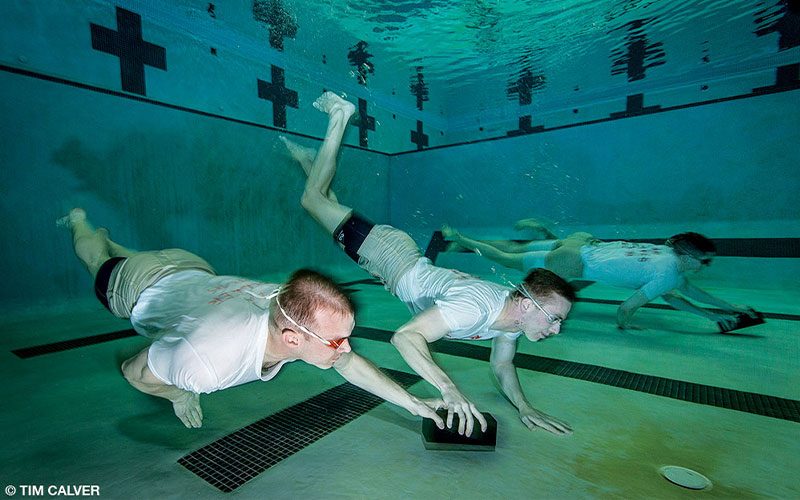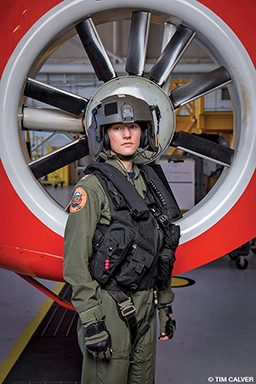The road to my U.S. Coast Guard Rescue Swimmer project began on a hot and still Bahamas day in 1997. Freediving from a small boat 2 miles off Bimini, I dived too deep, held my breath too long and experienced shallow-water blackout. My dive partner saved me from drowning. By the time I was rescued I had inhaled three breaths of salt water. I took a late-night helicopter ride to Miami and spent a night in the hospital coughing up seawater. Looking back I count myself lucky to be alive, having walked away from the experience with little more than pneumonia and a reasonable but somewhat limiting fear of breath-hold diving to 100 feet.
I have since gone on to a 20-year career as a freelance underwater photographer. In that time I have shot the majority of my assignments while freediving and have tried to focus my camera on people who dedicate their lives to the ocean — researchers, conservationists, freedivers, filmmakers and swimmers. With each story I hope to document what the subjects’ relationships with the ocean mean to them personally.

At the top of my list of hoped-for assignments was the chance to work closely with the rescue swimmers of the U.S. Coast Guard (USCG). These are the people who respond to the call when boaters or divers have trouble in U.S. coastal waters. They continually practice skills to enhance their ability to manage stress, fear and time underwater. They train to compete directly against dark waves, strong currents and hurricane-force winds.
I was curious about the conditioning that allows swimmers to excel in the absolute worst conditions. I wanted to see if it was possible to train away one’s physical and mental limits.
To cover this story I traveled to three key locations on the USCG map: Savannah, Ga., where I qualified to exit a hovering helicopter; Elizabeth City, N.C., where I swam alongside recruits undergoing training; and Kodiak, Alaska, where the USCG conducts its best-known operations as often seen on TV.
The key to my project was qualifying under the USCG’s Duck syllabus. This is an accreditation that allows USCG volunteers to play the role of rescue dummy and thus allow helicopter crews to practice real-world search and rescue operations. After a pool-based swim test and a short lecture on helicopter egress, I was qualified to leave a hovering helicopter by the rescue hook, swim beneath the thundering machine, connect with the rescue swimmer and be hoisted back into the helicopter. All of this I did while cradling a waterproof camera. I got a water-level view of the coordinated efforts of swimmer and machine that told an important part of my story.

While the key to the project was the Duck qualification I gained in Savannah, the heart of it was at the Aviation Survival Technician school. At AST school, which is in a cavernous building on Air Station Elizabeth City in North Carolina, classes of young men (and occasionally women) enter an 18-week course designed to test, stress, train, condition and ultimately drop or pass the hopeful rescue swimmer recruits. Classes start with more than 15 recruits but may graduate only one or two candidates (or occasionally none at all).

Every recruit who participates in the course, regardless of whether he or she passes, undergoes an evolution that involves self-doubt. The doubt might be mental or physical. It may be encountered underwater while sharing a breath and pushing a brick from one end of the pool to the other. It might be encountered when hanging from the pull-up bar while a shouting instructor demands more repetitions. Or doubt might be encountered when fans and lights transform the pool surface to more closely resemble a rough sea, and six people with unknown injuries need to be rescued.
I know this because I spent a week in close contact with a group of recruits and witnessed both doubt and determination sweep across faces. Some of my strongest images were taken in these moments, and I can attest that while each recruit wanted to do another pull-up or swim another length underwater, they generally didn’t want to do it with a camera in their face.
In the extreme, an aircrew flies through the black of night in typically adverse Alaskan weather conditions in which snow and wind combine to make flying a straight course challenging. Below the helicopter, the same snow falls, but there are also waves, towering, breaking and freezing. But when the helicopter gets where it is going, the door opens, and a swimmer jumps out.
I began this project fascinated by the thought that rescue swimmers require a helicopter and a three-person aircrew to complete their mission. And conversely, a multimillion-dollar aircraft requires an athlete in a pair of fins to fulfill its mission. But after seeing the training in Elizabeth City, I understand that a rescue depends not on a powerful helicopter or a powerful swimmer, but rather on a team of people who have decided that this is their life’s work.
This entire hovering assembly of man and machine advances and defines the Coast Guard’s motto “so others may live.”
Prepare for the Worst
Emergencies such as the shallow-water blackout Tim Calver experienced in Bimini are all too common. Both training and quick action are necessary in such cases to prevent serious injury or death. The same is true of many injuries that occur in the water: Nonfatal drowning, hypothermia, decompression illness and cardiac and pulmonary problems can become unmanageable without quick, appropriate interventions. People who spend a lot of time in aquatic environments must be trained and able to respond to emergencies when the nearest help could be more than an hour away.
The DAN® Diving First Aid for Professional Divers (DFA Pro) course is one way to prepare yourself to respond to these kinds of emergencies. Designed for professionals and volunteers who need to be prepared for the unique and challenging nature of aquatic environments, the course is USCG approved and meets or exceeds first aid and CPR requirements for both merchant mariners and diving professionals. The course provides training in the management of aquatic emergencies such as scuba diving incidents, injuries caused by marine life and neurological and cardiopulmonary emergencies.
Explore More
| © Alert Diver — Q3 2017 |